Chord Piano Lesson - Chord InversionsIn our next chord piano lesson we're gonna talk about chord inversions. There's only one problem. Imagine we have to play two chords one after the other. The first chord would be C major for example and second one would be F major. These two chords are often played one after the other. Try to play them. 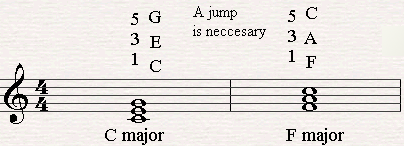 Did you try it? If you did you probably noticed that lifting your hand and jumping to another area on the piano was unavoidable. This jump creates an unfriendly pause between the two chords and that disturbs the continuity in the music. For that reason we will learn in todays chord piano lesson to play chords in different inversions. By connecting chords with the right inversions you create a voice leading. Alright, let's look at C major for example. C major is built out of three notes C, E, G. This is what we call the 1st inversion. 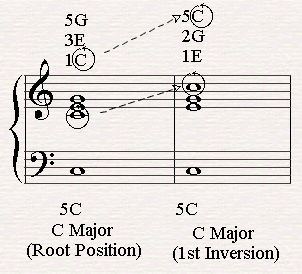 If you'll listen to this inversion you'll notice that it has a more open sound. The replacement of the root note above the two other notes allows the chord to develop harmonically more easily. Now for the second inversion; we have to repeat the same procedure by replacing the E chord which is now the lowest note of the first inversion above G and C. 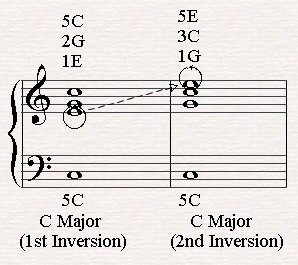 If we continue this procedure and place the G above C and E again we'll get back to the root position of the chord. To conclude one can say that chords of three voices/notes have three inversions only: The root inversion, the 1st inversion and the 2nd inversion. 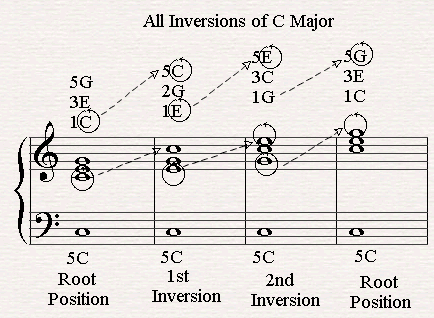 We can perform this process with all the chords we've learned. Here are a few examples of different types of chords (Left to the note names you'll find the right fingering of the different chord inversions). 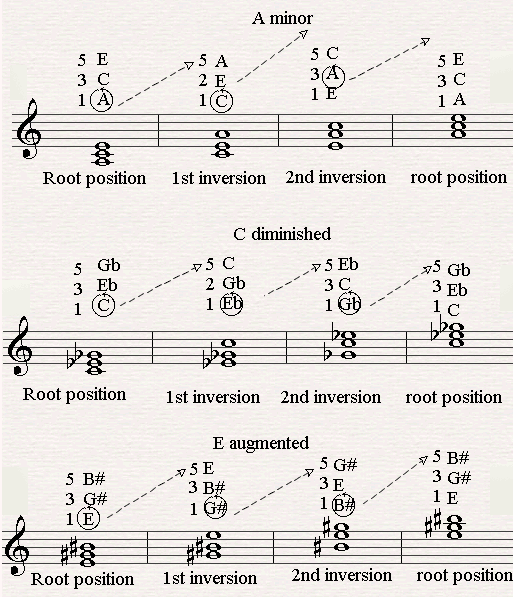 Find the inversions of the following chords : C, G, F, D, E, Am, Dm, Em, Cm If you follow the instructions in this chord piano lesson you'll notice that finding the chords inversions gets easier from time to time. How to Practice Songs With Inversions?That's a good question. Luckily for you I have a straight answer for it in this very chord piano lesson! Remeber the example I showed you at the beginning of this chord piano lesson? Where we tried to find a smooth way to change from C major to F major? The verse looks like this: 4/4 | C | F | C | F | x2 O.k. so before we've learned about the inversions in this chord piano lesson we would play a basic C chord for four counts and then jump to the basic F chord and play it for four counts, but now we know better. 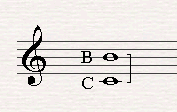 Next to the piano tabs in "Piano Play It" you'll find and interval definer. The interval definer tells you which area of the piano you're supposed to find your chord inversions on. Now if we combine both chords we'll realize we don't have to jump any longer. If we go from the C position to the 2nd inversion of F major all we have to do is raise the upper two keys (E and G) one white key to the right to F and A and back. 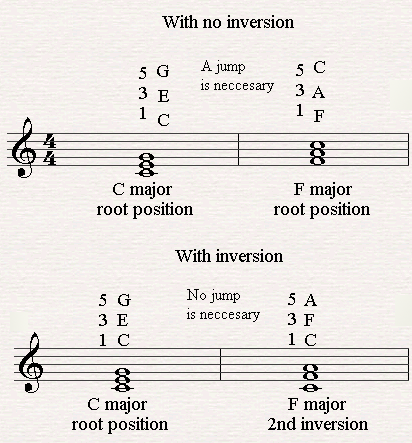 This is basically it for this chord piano lesson. My suggestion to you is that when you choose a song, first practice the inversions of all the chords it contains and then move slowly through the song and find one inversion after the other in the chord progression of the song. If you don't seem to find a chord inversion of a chord just go to its root position and climb the inversion carefully. Here's a list of songs to begin with: One Love - Bob Marley(Click here for the piano tutorial).Imagine – John Lennon (Click here for the piano tutorial). Let It Be – Beatles (Click here for the piano tutorial). One – U2 (Click here for the piano tutorial). In our next chord piano Lesson I'd like to talk about slash chords. Click here to learn about slash chords.
|
How To Play Piano by ChordsTHE FAST AND EASY WAY TO LEARN PIANO! The Ultimate Piano by Chords Learning Kit "Your entire site is simply fantastic. I really loved it. Now I am learning the basics of piano by myself, with your really great help. Thank you very much!" Jaime C. from Brazil "I only started to play about six weeks ago but the last hour of watching your videos about chord progressions has been something of a revelation. You're brilliant!!!!" Stephen Roberts from U.S.A "I'm a beginning keyboard player and your video's are an excellent guide. You're absolute not in a hurry, and take time to explain. I'm sure I'll follow all your lessons to get the hang of playing the piano/keyboard!" Wouter E. from the Netherlands "Thanks for all your work ( tuto and others ). You're doing a really great job, You're the best internet teacher I know." Anthony Hassen Cohen from France |
||||
|
Enjoy This Site?
Then why not use the button below, to add us to your favorite bookmarking service? |
|||||
|
| Homepage |
Site Map |
Just Added |
Buy Us Coffee! |
Sign up / Freebies |
Recommended Products |
Articles & Reviews |
Blog |
Beginners Course |
Accompaniment Course |
Notes Lessons |
Playing Technique | Chords | Theory| Tutorials | Sheets | Forum | Piano Videos | History | Piano Stuff| Keyboards and Pianos| |
|||||
|
Copyright piano-play-it.com © 2008-2017. | |||||














